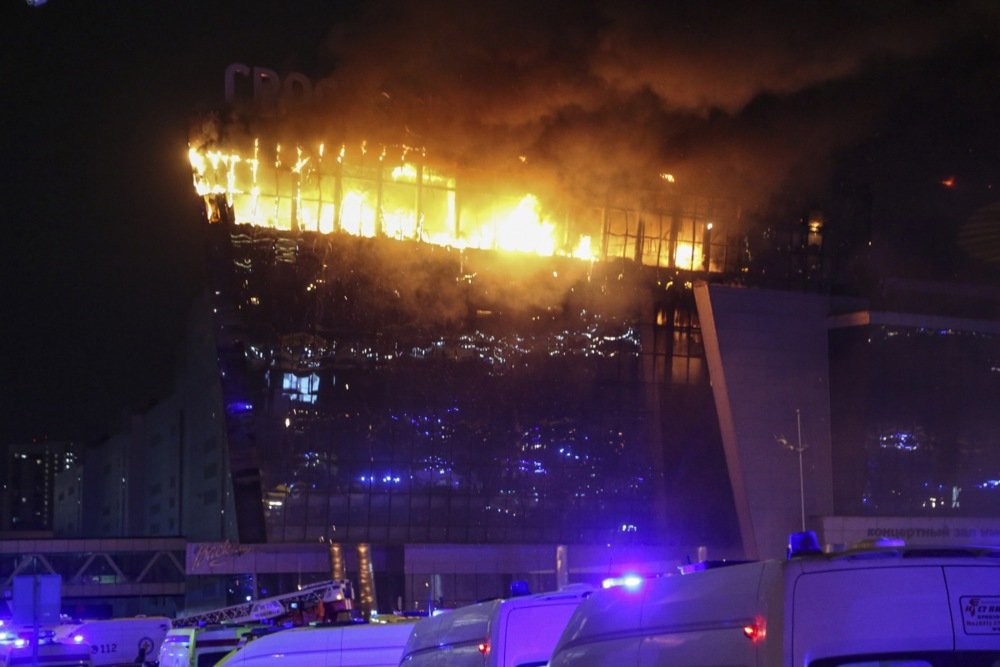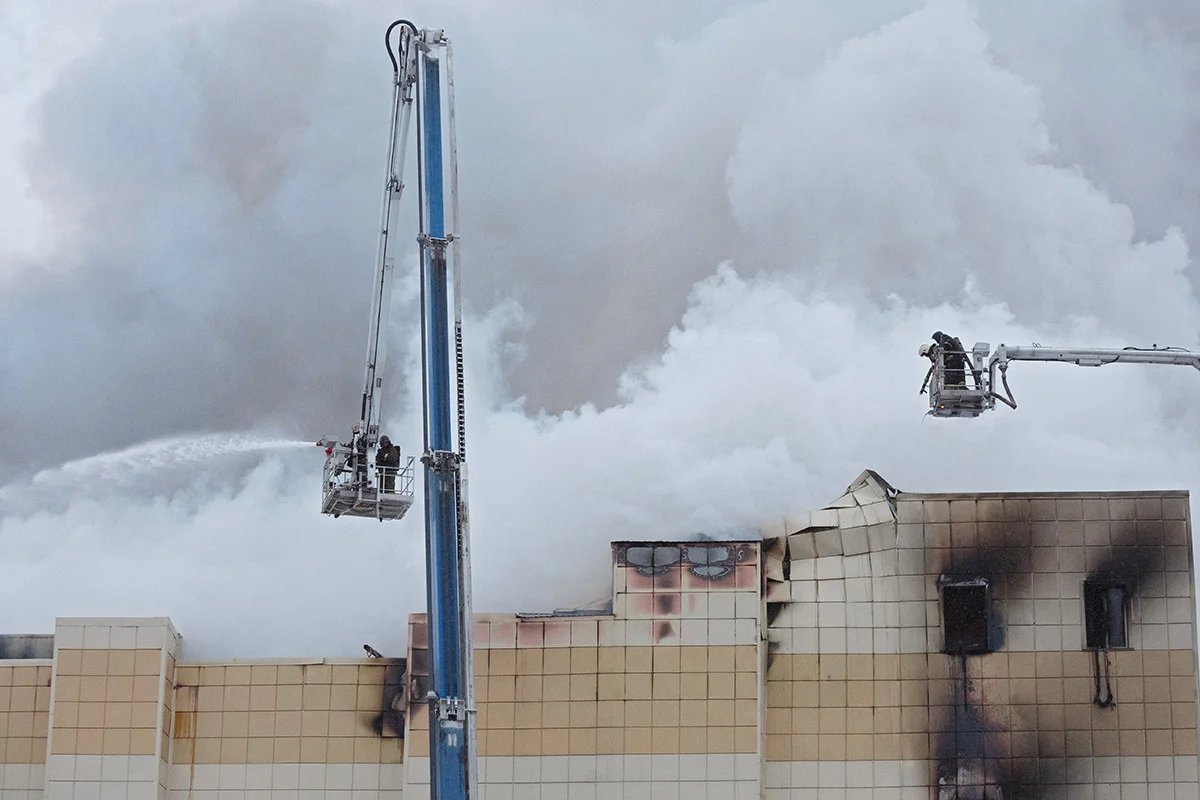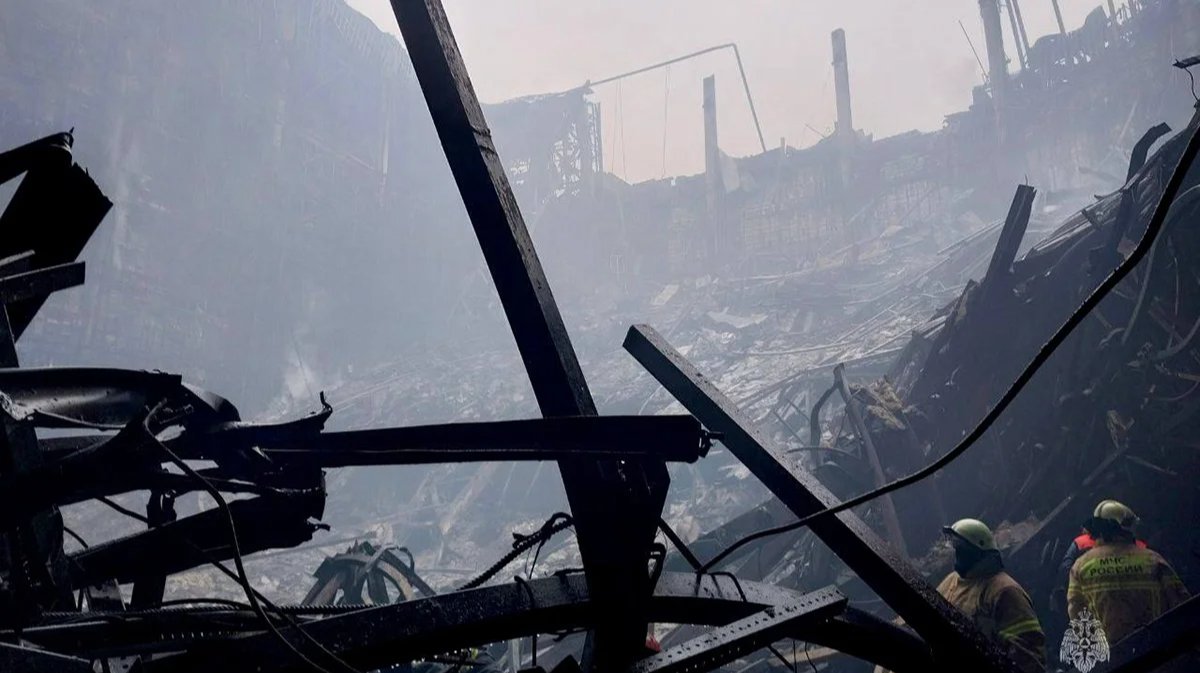In the end, it may not have been the bullets the gunmen fired into the crowd of concertgoers at Moscow’s Crocus City Hall that claimed the most lives on Friday, but the fires they started in the venue at the same time.
The multiple fires engulfed 13,000 square metres of the building, gutting large parts of it, and causing the roof to collapse. Firefighters only succeeded in extinguishing the blaze the following morning with the help of helicopters and at least 160 tonnes of water.
The death toll of the terror attack currently stands at 143, with Russia‘s Investigative Committee concluding that “gunshots and smoke inhalation” were the main causes of death.
Novaya Gazeta Europe looked at how Russia, where fire-related fatalities are three times higher than the global average, is paying a high price for the widespread violation of fire safety regulations enabled by endemic corruption.
‘More died from toxic smoke than terrorists’ bullets’
It took 320 firefighters and three helicopters to extinguish the fire at Crocus City Hall. Firefighting expert Vladimir Breget told Novaya Europe that he believed the attackers used accelerants when starting the fires, which in combination with the ventilation provided by the high ceilings led to the flames rapidly rising to the ceiling.
The abundance of combustible materials such as plastic and wood in the concert hall, as well as the upholstery of the chairs and tables, stage decorations and the lift mechanisms, all fueled the fire, he added. “I think more people died from toxic smoke while hiding from the terrorists' bullets.”
As concertgoers were hiding, the building began to collapse, which Breget attributes to a lack of fire and heat proofing on the roof’s metal structure.
Those who were fortunate enough to escape falling rubble were unable to leave via the emergency exits, which one witness told Telegram channel Baza had been locked, forcing some 400-500 people out of the 6,000 total concertgoers to escape via the main entrance.
A firefighter who spoke to Novaya Europe on condition of anonymity said that his colleagues at the scene had been heroic in their efforts to extinguish the fire. Despite this, the fire was not brought under control until the next morning, something Breget believes was due to a lack of modern firefighting equipment. Moreover, the probable lack of fire and heat proofing of the roof, in addition to the blocked fire exits, is indicative of wider violation of fire safety regulations that likely contributed to the number of fatalities.

The fire at the Crocus City Hall concert venue in Krasnogorsk, Moscow, March 22, 2024. Photo: EPA-EFE/VASILY PRUDNIKOV
An unprecedented level of corruption
Sergey Ivanov*, a former employee of the Ministry of Emergency Situations, which is responsible for fighting fires, told Novaya Europe that the already poor standard of fire safety in Russia would likely only worsen in the future due to widespread corruption.
“The appropriation of public funds was blatant when I was working there. Now my former colleagues say that corruption is at an unprecedented level.”
Describing the ministry, Ivanov says one half is made up of those who deal with the fires, such as firefighters, their superiors and dispatchers. The other half is made up of inspectors responsible for identifying the causes of fires, conducting inspections and enforcing fire safety regulations.
The tension between the two groups can be seen nationwide at every level, something Ivanov attributes to widespread corruption on the part of the inspectors.
“If you don’t take your share like everyone else, you will be dismissed. There is even an office quota for how much inspectors should take. When a low-ranking official takes a bribe it is understood that he will give some of it to higher-ups.”
Fire safety regulations save lives. By paying off inspectors to overlook costly requirements such as maintaining functional emergency exits, insulating electrical wiring, using fire-resistant building materials, and providing emergency fire fighting equipment including working fire extinguishers, lives are being endangered.
However these measures are expensive to install and maintain, and many businesses simply choose to bribe safety inspectors into overlooking violations, knowing that they’ll expect a bribe anyway.
“Of course I am not a professional firefighter, and I was not at the venue that night, but I often dealt with fires, or rather their aftermath. In my opinion, the fires on the roof and the upper floors spread very quickly, meaning either there was either insufficient manpower behind the firefighting effort that night, which is unlikely, or that the venue was built in gross violation of fire safety regulations.”

A Russian fire fighting helicopter at the Crocus City Hall concert venue in Moscow, 22 March 2024. Photo: Maxim Shipenkov / EPA-EFA
Three times higher than the global average
Open data platform To Be Precise calculated that 8,000 Russians died in fires in 2022, a figure per capita almost three times higher than the global average.
Most fire deaths are actually caused by inhaling toxic smoke rather than by the flames themselves.
However, the main reason for such a high death toll according to Sergey Sokolov, professor at the Academy of the State Fire Service of Emercom of Russia, is the lack of fire safety awareness. Indeed, Russia’s recent history is littered with instances of devastating fires found subsequently to have been started or aggravated by flagrant violation of fire safety codes and practices.
The Winter Cherry shopping centre fire

Extinguishing the fire at the Winter Cherry shopping centre in Kemerovo, 25 March, 2018. Photo: Sergey Gavrilenkov/Kommersant/Sipa USA/Vida Press
Faulty wiring caused the 2018 fire in the Winter Cherry shopping centre in the Siberian city of Kemerovo. The fire began in a children’s play area and engulfed an area of 1,600 square metres.
Initial safety measures failed when the centre’s sprinkler system and fire alarm failed to activate. Many of the victims were in cinemas on the same floor where the fire broke out and were unaware of the danger until smoke began to fill the rooms. Locked doors meant they were unable to escape and, eventually, the roof collapsed. The death toll reached 60 people, including 37 children, with 79 others injured.
Fire at the Lame Horse Club, Perm, 5 December 2009
As a nightclub in the city of Perm celebrated its eighth anniversary, a fire broke out when sparks from so-called cold fountains (fireworks that can be set off inside due to the low temperatures at which the sparks burn) ignited decorations on the ceiling. A recent, unauthorised renovation of the property had seen the windows bricked up, and the narrow corridors made it hard for the 250-350 guests to evacuate. Without signs to the emergency exits, the crowd panicked and began to stampede. The fire and smoke spread quickly and 156 people died.
Fire in the Admiral shopping centre, Kazan, 11 March 2015
A blaze broke out in a cafe adjoining the Admiral shopping centre in Kazan, the capital of Tatarstan. Faulty wiring was later found to have caused the outbreak of the fire, which spread quickly to engulf 4,000 square metres of the next door shopping centre, and caused its roof to collapse, trapping a number of shoppers inside the burning building. The fire was not brought under control until the evening, necessitating a massive fire fighting response that included 76 fire trucks, three helicopters and a fire train. In total, 19 people were killed in the fire and over 70 more were injured. The director of the company renting out the cafe’s premises received a 13-year jail sentence for criminal negligence, while another 12 defendants were given between four and a half to 13 years in prison.
*Not his real name.
Join us in rebuilding Novaya Gazeta Europe
The Russian government has banned independent media. We were forced to leave our country in order to keep doing our job, telling our readers about what is going on Russia, Ukraine and Europe.
We will continue fighting against warfare and dictatorship. We believe that freedom of speech is the most efficient antidote against tyranny. Support us financially to help us fight for peace and freedom.
By clicking the Support button, you agree to the processing of your personal data.
To cancel a regular donation, please write to [email protected]

